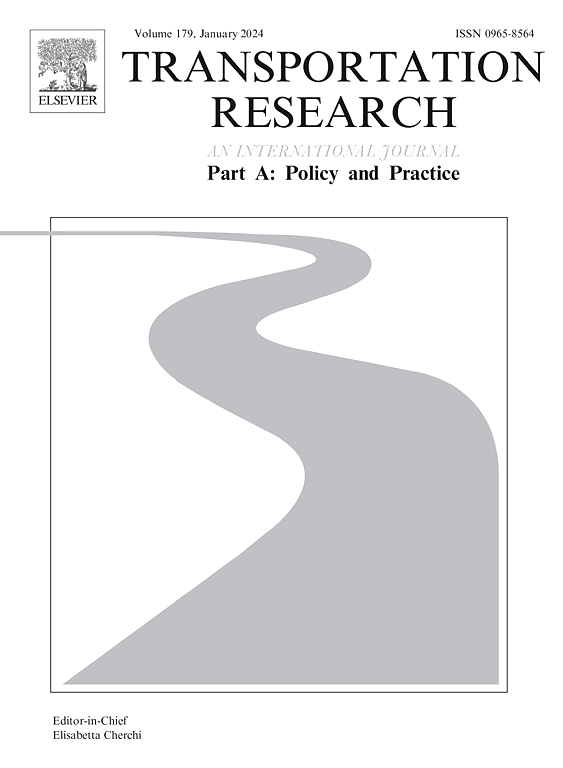Identifying potential market of advanced ride-hailing services with taxi-to-taxi transfer using a latent class choice model
IF 6.3
1区 工程技术
Q1 ECONOMICS
Transportation Research Part A-Policy and Practice
Pub Date : 2025-05-30
DOI:10.1016/j.tra.2025.104543
引用次数: 0
Abstract
This study examines people’s preferences for advanced ride-hailing-based taxi platform services aimed at addressing late-night taxi shortages. These new services are defined as a combination of taxi-to-taxi transfers, ride-pooling, pre-booking, and car type. A stated-choice experiment is designed to assess people’s willingness to use various hypothetical services. The respondents are limited to those using taxis at night in Gangnam, Seoul, with a sample size of 1000 individuals. A latent class choice model is estimated using stated choice data to identify the potential market for new ride-hailing services. The analysis reveals that the market can be categorized into three subgroups, with significant heterogeneity in preferences for new services among these subgroups. The potential market for new services is associated with individuals’ socio-demographics, such as gender, main activity time, and frequency of taxi usage. Among the two groups likely to choose alternative taxis, one group is sensitive to fares and shows relatively low resistance to short transfer waiting times and advance reservations, suggesting that an appropriate fare discount could increase their likelihood of using the new services. The other group prioritizes guaranteed dispatch over fare discounts and exhibits relatively high resistance to time-related factors, indicating that a strategy focused on providing high-quality services with enhanced time flexibility could be effective. Notably, the two groups show distinct differences in their preferences for ride-pooling. To the best of our knowledge, this study is the first to identify the latent market for new taxi services, including taxi-to-taxi transfers. The results provide insights into the factors affecting taxi service decisions, including taxi-to-taxi transfers and ride-pooling.
使用潜在类别选择模型识别出租车到出租车换乘的先进网约车服务的潜在市场
这项研究调查了人们对先进的基于叫车的出租车平台服务的偏好,旨在解决深夜出租车短缺的问题。这些新服务被定义为出租车到出租车接送、拼车、预订和汽车类型的组合。一个状态选择实验旨在评估人们使用各种假设服务的意愿。调查对象以首尔江南区夜间乘坐出租车的1000人为对象。使用陈述选择数据估计潜在类别选择模型,以确定新的乘车服务的潜在市场。分析表明,市场可以分为三个子群体,这些子群体对新服务的偏好存在显著的异质性。新服务的潜在市场与个人的社会人口统计数据有关,如性别、主要活动时间和使用出租车的频率。在可能选择替代出租车的两个群体中,一个群体对票价敏感,对缩短换乘等待时间和提前预订的抵制程度相对较低,这表明适当的票价折扣可能会增加他们使用新服务的可能性。另一组优先考虑保证调度而不是票价折扣,并且对时间相关因素表现出相对较高的抵抗力,这表明侧重于提供高质量服务并增强时间灵活性的策略可能是有效的。值得注意的是,这两组人对拼车的偏好存在明显差异。据我们所知,这项研究首次确定了新型出租车服务的潜在市场,包括出租车到出租车的换乘。研究结果揭示了影响出租车服务决策的因素,包括出租车到出租车的换乘和拼车。
本文章由计算机程序翻译,如有差异,请以英文原文为准。
求助全文
约1分钟内获得全文
求助全文
来源期刊
CiteScore
13.20
自引率
7.80%
发文量
257
审稿时长
9.8 months
期刊介绍:
Transportation Research: Part A contains papers of general interest in all passenger and freight transportation modes: policy analysis, formulation and evaluation; planning; interaction with the political, socioeconomic and physical environment; design, management and evaluation of transportation systems. Topics are approached from any discipline or perspective: economics, engineering, sociology, psychology, etc. Case studies, survey and expository papers are included, as are articles which contribute to unification of the field, or to an understanding of the comparative aspects of different systems. Papers which assess the scope for technological innovation within a social or political framework are also published. The journal is international, and places equal emphasis on the problems of industrialized and non-industrialized regions.
Part A''s aims and scope are complementary to Transportation Research Part B: Methodological, Part C: Emerging Technologies and Part D: Transport and Environment. Part E: Logistics and Transportation Review. Part F: Traffic Psychology and Behaviour. The complete set forms the most cohesive and comprehensive reference of current research in transportation science.

 求助内容:
求助内容: 应助结果提醒方式:
应助结果提醒方式:


